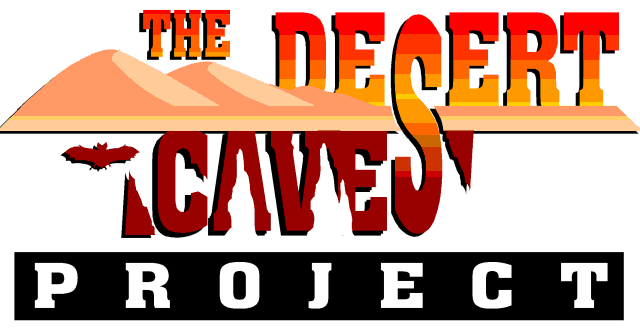MURUBBEH: THE CRYSTAL PALACE
In his survey of dahls near Ma'aqala, Saudi Arabia, Dave Peters mentioned a Bat Cave only five kms southeast of Sultan and one day in 1994, we decided to hunt for it. Not having any GPS coordinates
or we would have had hoped for a
satnav, our friend Dave Canning simply aimed us in the right direction and after five kms we had a look around. In no time we had found three or four sets of smallish holes before driving up to a big collapse, about fifteen meters wide.
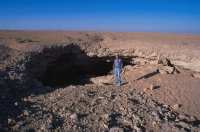
Picking our way down the steeply sloping breakdown, we found ourselves in a large room fifty meters across. Sunlight streaming from the entrance showed us patches of picturesque red sand beyond a field of broken rocks. The far wall immediately attracted our attention. "It's like a giant tostada floating in the air," shouted Susy. What she had found appeared to be a thin, lacy layer of calcite that had separated itself from the wall ages ago. It really did appear to be suspended there and, of course, it was extremely fragile. This Tostada Curtain covered many square meters of cave walls.
By now, Dave and Carol Canning were well into a side passage from which we could hear shouts of "lots of bones" and "Computer tape." As for the bones, there were at least three collections of them and no way to tell how deep the deposits might go. They looked like camel bones to us, but no one could imagine how or why a whole herd of camels could have or would have negotiated two very long and steep climb-downs (one in complete darkness) as well as the narrow passage leading out of the big room. Without a doubt, an archeologist could have a field day reconstructing what actually transpired in this place and when.
Computer tape, similar to that left in Dahl Sultan, stretched off into the darkness, reinforcing our belief that this might indeed be Bat Cave. But where were the bats?
C'EST INCROYABLE
Once again, I heard shouts up ahead. "Incroyable! Extraordinaire!" exclaimed Christophe, while Dave Canning's voice echoed from a small passage on the right: "John, you've got to see this."
Moving forward, I found more walls covered by the gypsum "tostada facade," while in other places, thin wafers of this stuff, maybe 10 cm around, were perpendicularly "glued" to the wall or ceiling, that is, sticking straight out from it. How they got themselves into such a position, I could not imagine.
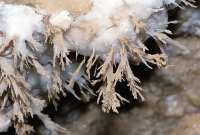
Christophe and Susy's "incroyable" find left all of us gasping. The low ceiling was covered with hundreds of crystals which resembled feathers dipped in frost. They were only six cms at the longest, but the heaped up breakdown permitted us to get as close as we wished.
None of us had ever seen crystals like these before and all our attention was focused on the nine square meters or so of ceiling where this curious crop of "feathers" had grown.
TEEN-AGE FIREFLIES
Then we noticed the fireflies. At least, that's what they looked like at first: three or four tiny pinpoints of light bobbing around far down the passageway. But after a moment or two the fireflies turned into candles and we could hear the voices of their owners.
Never having encountered anyone but ourselves in a Saudi cave before, we were a bit apprehensive. What was this approaching party after? Would they look upon us as intruders?
As the candle-lit figures drew near, we saw the happy faces of several laughing and joking teenagers dressed in long white thobes and sandals. These boys appeared delighted rather than annoyed by our presence in "their" cave, and we soon learned they were from the nearby community of Shawiah. This cave, a perpetually cool respite from the outrageous heat of summer as well as the cold winds and sandstorms of winter, was their favorite weekend hangout. They called it Murubbeh, or "The Square Place" according to Andy Thompson, who did an excellent job as translator.
While the boys enjoyed themselves posing for pictures with some members of our gang, Christophe and I finally made our way over to the side passage Dave Canning had been raving about.
BEAMED TO ANOTHER PLANET
You shine your light into this tunnel and you're immediately dazzled by the sparkling reflections of light. Both ceiling and floor are made of flowstone and stalactites with plenty of thin "tortilla chips" glued on. We carefully maneuvered our way through the delicate ceiling appendages, but every footstep we took sounded like an elephant tiptoeing through a bin of broken champagne glasses. At the end of the short passage, Dave invited us to stand up in two little rooms the size of telephone booths.
Standing in one of these Starlight Chambers is like finding yourself inside a geode. A universe of twinkling lights are reflected from your headlamp: 360 degrees of mesmerizing, tantalizing sparkles that make you feel you've been beamed to another dimension.
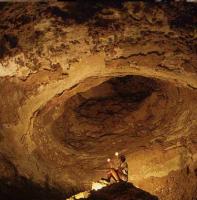
The fragile beauty of Murubbeh Cave reinforced our worries about the future of Saudi Arabia's Dahna Desert Caves. The two decorated caves we had thus far discovered, Sultan and Whistling TeaPot had tiny entrances requiring vertical gear and agility. Murubbeh, instead, had an inviting, walk-in entrance and a large room with natural lighting. How many visitors would it take until the "wrong person" came along with a hammer in one hand and a gunny sack in the other?
Keeping quiet about our discoveries might have benefitted the blowhole caves, but we felt that Murubbeh needed protection, so we put together a slide show and began our search for people that might be willing to start a Cave Conservation project for Saudi Arabia. I was busy teaching and it was Susy who did all the work. Surprisingly, our first breakthrough came not from phone calls but from our friend Pat Mosher who arranged an appointment for us with Hesham Elabd of the Riyadh Development Authority who saw our slides and immediately declared, "I would like to see this cave. When can we go?"
CELSIUS 45.1
At this time of the year, temperatures were over 45 degrees C (112 degrees F) and you could fry out in the desert if you ever had an accident. However, we easily found two more carloads of volunteers for a camping/caving trip and a week later, there we were, following Hesham's GPS ... well, not exactly back to Murubbeh Cave, but very close. Close, however, isn't good enough when there's nothing in sight anywhere to use as a landmark. So, as the sun began to set, the three vehicles in our expedition were frantically driving around in circles trying to find ──but not fall into── a hole 15 meters wide.
Finally, the sun slipped below the horizon. We had hoped to spend the evening studying and surveying the cave, but it now looked like we'd be camping just anywhere... so near and yet so far... when suddenly we saw a distant set of headlights blinking in the darkness. One of the cars had found it!
So, a combination of satellite technology and good luck allowed us to camp next to Murubbeh's entrance, which, in turn, alerted us to the comings and goings of the bat colony we had been looking for. And those bats led us through a small, unpretentious opening into a whole new section of the cave we had never seen before.
FREEZING IN THE DESERT
Showing off the cave to new visitors brought to light so many details we ourselves hadn't spotted earlier, that suddenly it was 10:00 PM and we hadn't surveyed an inch. Susy and I decided we would at least start the job and made our way to the far end of The Camel Aisle. However, after only two stations, we had to give it up. "I'm freezing," claimed Susy, which prompted me to consult my handy Campmor keychain thermometer. 65 degrees F is what it said.
"What?" cried the people outside when I told them why we'd abandoned the survey, "it's nowhere near that cold in there. Besides..."
"Yes, I know," I replied, "Saudi caves are always a nice warm 78 degrees C (26 F) all year 'round... but this one is cold. Maybe that's because it's twice as deep as the other caves around here."
That night, Susy and I set up our tent on the Sand floor of the Clubhouse. The very fact that we were soon snuggled up inside our sleeping bags convinced me that my little thermometer had been correct.
Suddenly, in the middle of the night, my eyes popped open. Something was wrong, but I didn't know what. I had heard a few passing bats and even the wings of an owl without fully awakening, but now there was something else. And then I saw it, a faint beam of reflected light barely visible through the door mesh. It was a car's headlights, I decided, but the night was dead quiet, so they had to belong to one of our own... After a few moments, the lights went out and I drifted back to sleep.
The next morning, over a hearty breakfast, we heard the story of The Great Camel Spider Walkabout.
FANGS
Three members of our party had found it too warm to sleep (and for some strange reason, hadn't wanted to sleep in the nice, cool cave). At midnight, these three decided to go off for a little walk. By this time there was no light coming from our campsite, so they made it a point to keep in mind which way was back. However, in the course of their wanderings, they came upon a camel spider, a big, hairy creature noted for its ugliness and enormous fangs. Fascinated, the trio ran this way and that, wherever the wee beastie led them, until finally it disappeared down a hole. Then, of course, came the moment of reckoning: "I say, does anyone recall which way we came from?" No one had a clue.
X suggested the "great circle" technique. The other two should stay put while he would walk in a wide circle, communicating with occasional flashes of light. "I'm bound to come near the camp sooner or later," said X.
Y, however, the more he thought about it, was convinced that a certain distant glow corresponded to the correct direction of the camp. "We'll save lots of time if you just walk towards the glow," he told X.
So, X set off for the glow, but after an hour and no sight of camp, headed back towards his occasionally blinking companions. "So much for that theory. Now let's try my idea."
The circular approach turned up the camp's location fairly quickly, but when the midnight hikers finally collapsed on their cots, it was 4:00 AM, just a few minutes after someone had finally noticed their absence and had flashed his headlights, the reflection of which had awoken my Inner Watchman, down inside the cave.
SAVE THE CAVES
Susy's contacts eventually led her to two outstanding women who arranged for us to be interviewed on a children's TV show as well as a popular program on environmental issues. The children were so enthusiastic and had so many questions on caves, conservation and bats, that we ended up filming four shows. A month later we were pleading the cause of Saudi Cave Conservation on nationwide TV practically every day and we had high hopes that all the hullabaloo would catch the eye of someone who would like to see the Desert Caves preserved for future generations.
As a matter of fact, word did reach a certain important gentleman who suggested we set up a trip so he could have a look at the cave.
I phoned up Dave Canning. "Hello Dave. Now that it is midJune and thermometers that only go to 50 C are exploding everywhere, only a genuine madman would want to drive out to the caves, right? ... which is why I'm calling you..."
Knowing it would be my last chance to show Murubbeh Cave to an interested party, Dave agreed to a trip and we worked out a timetable that would avoid exposure of our parked vehicles to the full brunt of the noonday sun. "We can drive out late in the day, explore by night ── maybe even squeeze in that survey── and head back early the next morning," I suggested.
"I caught that casual aside about surveying," replied Dave, but I must admit I'd like to bring a digital thermometer into the Camel Aisle just to prove the temperature is not 65 F." Next, Dave the Mining Engineer went into an explanation of the Laws of physics governing underground rock temperatures which demonstrated that a few hundred meters this way or that way doesn't mean a thing, in fact an extremely deep cave would actually be warmer than one nearer the surface. I had to admit that my counter argument ("But it feels like 65 F.") didn't carry much weight against the laws of Newton and Einstein.
"MAJNOON" IN JUNE
A day or two before the trip, I got a call from the man who wanted to see the cave. Apparently someone had pointed out that it would be totally "majnoon" (crazy) to drive out into the trackless desert in near-50 C temperatures. So the trip was off. However, when I called up Dave, we discovered that each of us had secretly been looking forward to one last desert sortie and since when did a wee bit of heat ever stop dedicated cavers?
All we needed was a second vehicle, but this time I couldn't find a soul with a 4X4 interested in such a venture. So, at midnight we called it off. However, at 2:00 AM the phone rang. "Bob Tate here. Got your message saying I should reply no matter what time it was. You know, I'd sure like to see those caves..." I woke Dave to let him know the trip was back on... and may God help us.
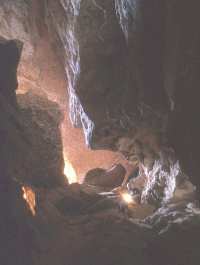
So, on June 22, 1995, I joined Bob and Sue, Dave Canning and the hardy Swedish underwater photographer, Erik Bjurstrom on the very last caving trip of the season.
Leaving late in the afternoon brought us to Murubbeh's entrance at early evening. A pleasant breeze was blowing and, although it wasn't cool, neither was it anything like the oppressive, stifling atmosphere of Riyadh in the summer. Without asphalt and concrete to retain the heat and buildings to block the breeze, we could imagine what the capital must have been like in olden times.
While Erik used his fisheye lens and indestructible underwater flashes and slaves to capture the wonderful features of the Crystal Palace, Dave and I proceeded to the far end of the Camel Aisle and began the survey. After a while, Dave said, " OK, I give up. I've been monitoring the temperature for half an hour and there's no doubt: it's 62 F in here!" It was a relief to know that my Campmor thermometer's reputation had emerged unscathed.
All we needed, then, was an explanation of why this passage, thirty-five meters deep, is much colder than nearby cavities at both greater and lesser depths. The best theory I've heard was given by geologist Chris LLoyd after seeing a video tape of the cave. He pointed out that the large entrance plus the closed-off lower passage form an ideal cold air trap which would be replenished every winter by the occasional near-freezing temperatures. Chris also pointed out that many formations in Murubbeh are very similar to those of Lechuguilla, suggesting that sulfuric acid may have played an important role in its formation.
Speaking of formations, our survey brought to light a conspicuously bare spot in the ceiling just next to the aragonite feathers. "Someone was at this with a hammer," exclaimed Dave. "It looks like there was a big gypsum formation up here." Sure enough, a look at the ground below revealed broken pieces of what were once grooved gypsum needles over a cm thick. Whatever they removed had been very different from the other formations in the cave, perhaps its crowning glory.
This cave, just like every cave anywhere in the world, is in danger of being defaced, covered with grafitti and filled with trash. At present, however, it is one of the most beautiful and fragile natural wonders of Saudi Arabia. In the end, it may be up to the people of Shawiah to take whatever steps may be needed to protect and preserve Dahl Murubbeh, their unique and beautiful Crystal Palace.
John J. Pint, June, 1995
| 








